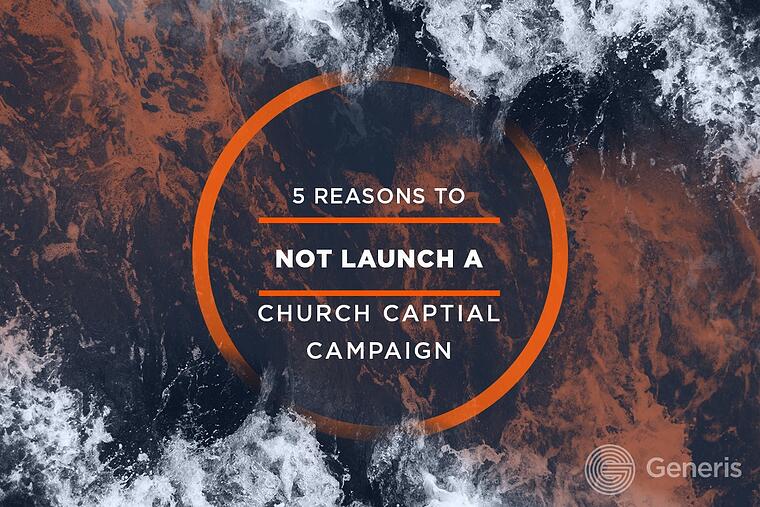
Congratulations! Your church is in a season of growth! But as a Lead Pastor or Executive Pastor, you’re aware of some space-related “choke points” developing that will hinder future growth if they’re not addressed. You may have a lack of seats in the worship center, not enough space in the children’s ministry area, or a run-down student ministry center with outdated technology.
As you’re recognizing the need to address these issues, you’re also recognizing the need for additional resources to fund the growth. Before long, the talk will likely turn to planning and implementing a major giving campaign of some kind.
But what should be the approach for your church? Is a traditional “over and above” type capital campaign the ideal solution? Are there other options that might provide the needed funding, while at the same time addressing other general stewardship and generosity issues that likely exist in your church?
ONE FUND INITIATIVES
There is an alternative approach to a traditional capital campaign, and it’s called a One Fund initiative. Rather than asking people to commit to a gift in order to fund a project (or projects) that is “over and above” their regular giving to the church, a One Fund asks people to consider their total giving to the church.
A One Fund asks three questions:
1. Where are you on the journey of giving back to God?
2. Where does God want you to be on that journey?
3. What would it look like to move in faith to that place God desires for you?
FIVE REASONS TO CONSIDER A ONE FUND INITIATIVE
1. Your giving metrics are not as strong as you would like.
A traditional capital campaign won’t change your giving metrics (much). You need an approach that leads with discipleship, not a project.
- Giving analyses of most client churches show:
- 30-40% of attendees give $0.
- 30-40% of attendees give $1-$500 annually.
- 80% of attendees give less than $10 per week.
- Traditional campaigns focus on funding the project(s) and that is one of the reasons this approach works so well. However, the limitation of traditional campaigns is that they do not impact general giving metrics significantly, if at all. Additionally, the traditional approach doesn’t onboard new givers well.
- In Two Fund (traditional) campaigns, attendees typically experience some ambiguity: “Over and above what?” For non-givers, a traditional campaign could potentially exclude them or, because they’re asked to go “over and above” nothing, they may experience only a short-term increase in giving—without true discipleship of growth in generosity.
2. You’ve done three or four capital campaigns in a row.
Repeated traditional campaigns may produce a diminishing return over time or may even feel routine. You need something fresh.
- A One Fund approach provides a true “this is different than anything we have done before” feeling, which is especially crucial to your faithful, long-time givers.
- A One Fund is groundbreaking; it evokes a more significant desire to invest from some givers who previously might have said, “Here’s my pledge. I know how this works, so I don’t need to attend any leadership or informational meetings.”
3. Your project may not inspire everyone in your church to participate.
Project-based campaigns may only interest people with a specific stake in that particular ministry.
- When my wife and I were young parents, a campaign to update or build new children’s ministry space would have really captured our hearts. We would have been “all in” as our kids were involved in that ministry, and so were we! Today that same vision would still garner our support, but because our kids are grown and we’re empty nesters, we might not have the same level of passion.
- Even more difficult are those campaigns for debt reduction or campus upkeep and maintenance. It’s not especially motivating to inspire large financial gifts to replace that million-dollar HVAC system.
- The vision cast in a One Fund includes every single ministry the church currently supports, along with new funding priorities you desire to add. It’s about children’s ministry, student ministry, missions, discipleship, outreach—everything you do. There’s something in it for everyone to get behind.
4. Your funding needs go well beyond the two- or three-year giving season a traditional campaign supplies.
A traditional capital campaign plan will raise funds for that new project on the board, but at the end of the giving season for the campaign, general giving remains about where it was when you started. Nothing bad about this, it’s just a reality with the traditional “over and above” approach.
So what happens with your ongoing ministry plan (budget)? It’s helpful to grow funding for existing ministries and missions and for new ministries you’d like to begin.
A One Fund initiative creates a “longer tail of generosity” as the initiative focuses more on the heart change of the giver, rather than on the need of the church to fund a project.
- Often in traditional campaigns, donors see their campaign commitment as “their” money. When a traditional campaign season ends, givers typically repurpose those “over and above” dollars back to their personal budgets. But in a One Fund, givers are less likely to return to a lower level of giving because they see the enhanced giving amount as growth in their relationship with Christ.
- In year three (the full year following the two years of a One Fund giving season) we’re seeing churches retain 40-60% of the new giving.
- For example, let’s say a church has $1 million in income prior to launching a One Fund. During the One Fund season, they double their annual giving to $2 million. That church will likely receive $1.4 million to $1.6 million in year three—after the “campaign” has officially ended.
5. You’re a growing church.
It’s difficult to onboard and engage new families who begin attending in the middle of your traditional campaign giving phase.
- We always try hard to engage new families, but most will view the campaign in progress as something you did before they arrived. They’ll often wait for the next one and plan to commit to that one when it rolls around.
- In a One Fund, a new attendee is part of the initiative as soon as they begin giving, since every dollar given goes into that one fund. Even without making a written commitment, a new giver has joined the effort.
ARE TRADITIONAL CHURCH CAPITAL CAMPAIGNS NO LONGER EFFECTIVE?
In closing, let’s be clear. The traditional capital campaign remains a healthy and viable approach to raising money and that might be the best approach for your church at this time. However, the One Fund initiative is a new, fresh, discipleship-based approach that may be a more effective direction for your church to consider. Unlike in the past, you have choices. At the very least, it’s a viable alternative that merits your attention.
Interested in learning more about the nuiances of church captial campaigns? Check out our latest eBook, The Hidden Costs of DIY Church Capital Campaigns.
Share this
You May Also Like
These Related Stories

Frequently Asked Questions in a Church Capital Campaign.

How Generous Churches Talk About Money


No Comments Yet
Let us know what you think